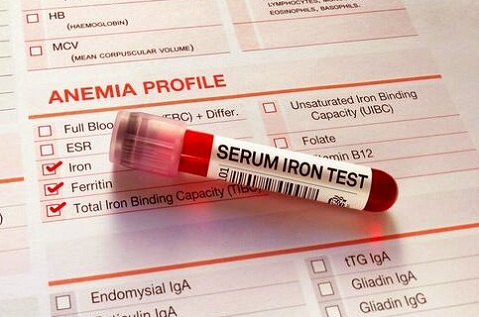Study Claims That a Mild Level of Iron Deficiency Might Actually Protect Against Viral Infections Including COVID-19
Nikhil Prasad Fact checked by:Thailand Medical News Team Dec 21, 2024 1 year, 5 days, 5 hours, 12 minutes ago
Medical News: A team of international researchers has recently shed light on an intriguing connection between iron nutrition and the risk of SARS-CoV-2 infection among healthcare workers in Nigeria. This study, spearheaded by experts from institutions including Binghamton University (USA), Lagos State University Teaching Hospital (Nigeria), University of Nigeria (Nigeria), and Michigan State University (USA), aimed to explore whether iron deficiency or excess could influence susceptibility to COVID-19. The findings provide a nuanced perspective on how iron levels interact with viral infections, particularly in the context of the ongoing pandemic.
 Study Claims That a Mild Level of Iron Deficiency Might Actually Protect Against Viral
Study Claims That a Mild Level of Iron Deficiency Might Actually Protect Against Viral
Infections Including COVID-19
The Study’s Background and Objectives
The study was rooted in the Optimal Iron Hypothesis (OIH), which suggests that a mild level of iron deficiency might actually protect against infections. Iron is vital for human immune function but is equally critical for the survival and replication of many pathogens, including viruses. Researchers sought to determine if this balance plays a role in susceptibility to COVID-19, specifically examining healthcare workers, who are at high risk due to their frontline roles.
This
Medical News report highlights the study’s core findings, methodology, and implications. With a focus on healthcare workers in Nigeria, it becomes evident how iron status - whether deficient, sufficient, or excessive - can impact not only individual health but also broader public health strategies.
The Methodology and Scope of Research
The research took place across four major hospitals in Lagos and Enugu states in Nigeria. Participants included 304 healthcare workers, with data sufficient for analysis collected from 199 individuals. These participants, drawn from COVID-19 wards and emergency units, were tested for iron deficiency, anemia, and SARS-CoV-2 infection over a three-month period. Using sophisticated statistical models, researchers analyzed how iron levels, anemia, and other factors influenced the likelihood of testing positive for SARS-CoV-2.
Key biomarkers assessed included hemoglobin levels to identify anemia and zinc protoporphyrin-to-heme ratios to measure iron deficiency. Saliva samples were used for bi-weekly PCR tests to detect SARS-CoV-2. The comprehensive approach ensured robust data collection, allowing for a detailed analysis of the relationship between iron status and COVID-19 susceptibility.
Core Findings of the Study
The study uncovered significant trends:
-Iron Repletion and Elevated Risk: Healthcare workers with replete iron levels were more than twice as likely to test positive for SARS-CoV-2 compared to those with lower iron availability. This finding aligns with prior research suggesting that high iron levels can facilitate viral replication.
t;
-Anemia and Infection Risk: Anemia, often associated with poor nutritional or health status, also correlated with increased susceptibility to SARS-CoV-2 infection. Anemic participants exhibited a heightened risk, regardless of their iron deficiency status, indicating that the interplay between iron and immune function is complex.
-Iron and Respiratory Symptoms: While iron repletion and anemia influenced SARS-CoV-2 infection rates, their impact on general respiratory symptoms, such as cough or fever, was less pronounced. This distinction underscores the unique dynamics of COVID-19 compared to other respiratory infections.
Interpreting the Optimal Iron Hypothesis
The findings provide partial support for the OIH. While mild iron deficiency appeared protective against SARS-CoV-2, the relationship was not as straightforward as predicted. Researchers observed elevated infection risks at both extremes of the iron spectrum - iron repletion and severe anemia. This suggests a “U-shaped” association where both low and high iron availability pose risks, but for different reasons.
Interestingly, the study also highlighted the importance of considering evolutionary dynamics. Many pathogens have evolved mechanisms to exploit host iron for replication. SARS-CoV-2’s ability to disrupt hemoglobin and increase free iron within the body may explain its enhanced replication in iron-replete hosts.
Broader Implications for Public Health
These findings carry profound implications for global health strategies, especially in regions where anemia and iron deficiency are prevalent. For healthcare workers, who are particularly vulnerable to infectious diseases, understanding the role of iron could inform nutritional interventions and workplace health policies.
Iron Supplementation Cautions
While iron supplements are commonly used to address anemia, this research suggests they should be prescribed cautiously, especially during infectious disease outbreaks. Excessive iron might inadvertently increase susceptibility to certain pathogens.
Conclusion and Future Directions
This research underscores the intricate balance required in iron nutrition to minimize infection risks while maintaining overall health. For healthcare workers in high-risk environments, optimal iron levels - neither too high nor too low - may be key to reducing vulnerability to infections like COVID-19.
The study’s authors advocate for further research into the mechanisms by which iron influences immune responses and pathogen replication. They also call for tailored public health interventions that account for regional nutritional and disease burdens. By addressing these complexities, future strategies can better protect not only healthcare workers but also broader populations from emerging infectious diseases.
The study findings were published in the peer-reviewed journal: Evolution, Medicine, and Public Health.
https://academic.oup.com/emph/advance-article/doi/10.1093/emph/eoae034/7929228
For the latest COVID-19 News, keep on logging to Thailand
Medical News.
Read Also:
https://www.thailandmedical.news/news/the-effects-of-dietary-iron-on-covid-19-infection-and-recovery
https://www.thailandmedical.news/news/iron-deficiency-observed-in-pediatric-covid-19-cases
https://www.thailandmedical.news/news/reduced-plasma-bmp6-levels-in-sepsis-new-insights-into-iron-regulation
https://www.thailandmedical.news/news/the-hidden-dangers-of-iron-overload-how-iron-can-harm-heart-cells
